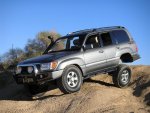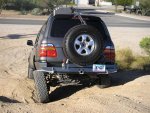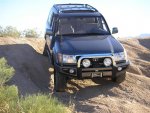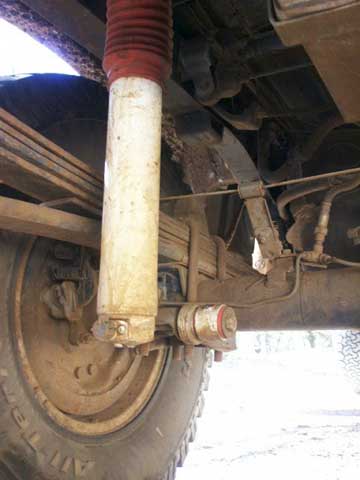ShottsCruisers
Explorer
Well, not sure how many 100-series drivers are posting to this forum? Regardless, I've pulled another "first to modify ..... on a 100-series" and it was a great success so I figured I'd get the word out just in case someone is searching.
PROBLEM: 100-series, while extremely capable, has less F&R wheel travel when compared to the 80-series. All types of ideas have been thought through regarding the front-end, though to no postive outcome. Nobody has been focusing on the rear-end however....except me. I'll explain:
One of the best improvements one can make to their 80-series suspension is to upgrade to OME L-series shocks. The L-series allow for 1.6" more rear travel and an overall 2.6-inch rear droop improvement over standard OME shocks. (The front L-shock improvement is a bit less due to other issues, though we'll focus on the rear-end for now) Because the L-shock is 1-inch longer, bump stops must be lowered to avoid shock damage.
IDEA: With an 80 and a 100 being so similar in the rear, why couldn't you take an 80-series L-shock and stick it on a 100-series? You'd guess the valving would be similar (as weights are). Travel would be similar (as the shock is the limiter). So why not try it? Well, I did, and the result is amazing.
HERE'S WHAT IT TOOK:
1. Put the lower shock bushings from a 100 shock into the L-shock
2. Use the upper L-shock bushings and washers, except for the very top washer and nut.
3. Use the top 100 shock washer and nut.
NOTES:
*My rear bump stops were already lowered 2" to accomodate 35-inch tires.
*I have 80-series OME863 springs
*I welded on a spring retainer (just as a precaution) to each spring seat just to make sure the spring wasn't going anywhere. The L-shocks are a mate for the 20mm taller OME J-springs which I don't have...too much lift for the rear compared to the front's limits.
RESULTS:
*On-road ride is undetectable from before. The valving must be the same or real close.
*Off-road the truck was MUCH more stable. Not only did the added droop and articulation fill the rear holes, the front wheels would compress upward easier because the rear was planted and working against the front.
All-in-all, I'm thrilled with the results. I never expected this improvement. The 100 needs help out there due to the lesser travel of the front IFS. This help closes the gap even tighter in overall capability to it's predecessor.
The entire story is here: http://shottscruisers.smugmug.com/Vehicle Specs and Modifications/117861
Pics (nice primer on my bumpers....Moab repairs):
PROBLEM: 100-series, while extremely capable, has less F&R wheel travel when compared to the 80-series. All types of ideas have been thought through regarding the front-end, though to no postive outcome. Nobody has been focusing on the rear-end however....except me. I'll explain:
One of the best improvements one can make to their 80-series suspension is to upgrade to OME L-series shocks. The L-series allow for 1.6" more rear travel and an overall 2.6-inch rear droop improvement over standard OME shocks. (The front L-shock improvement is a bit less due to other issues, though we'll focus on the rear-end for now) Because the L-shock is 1-inch longer, bump stops must be lowered to avoid shock damage.
IDEA: With an 80 and a 100 being so similar in the rear, why couldn't you take an 80-series L-shock and stick it on a 100-series? You'd guess the valving would be similar (as weights are). Travel would be similar (as the shock is the limiter). So why not try it? Well, I did, and the result is amazing.
HERE'S WHAT IT TOOK:
1. Put the lower shock bushings from a 100 shock into the L-shock
2. Use the upper L-shock bushings and washers, except for the very top washer and nut.
3. Use the top 100 shock washer and nut.
NOTES:
*My rear bump stops were already lowered 2" to accomodate 35-inch tires.
*I have 80-series OME863 springs
*I welded on a spring retainer (just as a precaution) to each spring seat just to make sure the spring wasn't going anywhere. The L-shocks are a mate for the 20mm taller OME J-springs which I don't have...too much lift for the rear compared to the front's limits.
RESULTS:
*On-road ride is undetectable from before. The valving must be the same or real close.
*Off-road the truck was MUCH more stable. Not only did the added droop and articulation fill the rear holes, the front wheels would compress upward easier because the rear was planted and working against the front.
All-in-all, I'm thrilled with the results. I never expected this improvement. The 100 needs help out there due to the lesser travel of the front IFS. This help closes the gap even tighter in overall capability to it's predecessor.
The entire story is here: http://shottscruisers.smugmug.com/Vehicle Specs and Modifications/117861
Pics (nice primer on my bumpers....Moab repairs):
Attachments
Last edited:




